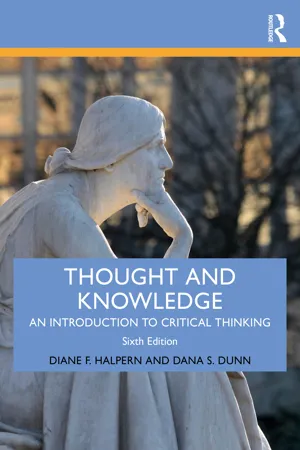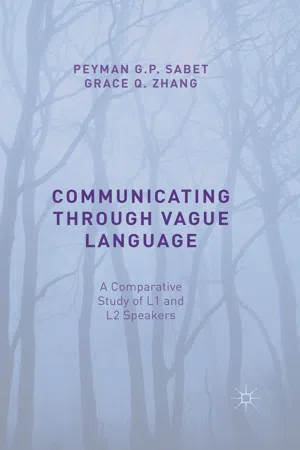Equivocation
Equivocation refers to the use of ambiguous language to conceal the truth or mislead others. It involves deliberately using words with multiple meanings to create confusion or to avoid giving a clear answer. This rhetorical strategy is often used in debates, arguments, or persuasive communication to manipulate the meaning of a statement.
4 Key excerpts on "Equivocation"
- eBook - ePub
Thought and Knowledge
An Introduction to Critical Thinking
- Diane F. Halpern, Dana S. Dunn(Authors)
- 2022(Publication Date)
- Routledge(Publisher)
...Nice sentiment, but without the specific actions they would take to achieve this goal, they are hollow words. This statement is far too vague to be meaningful. Equivocation occurs when the meaning of a word is changed in the course of the same discussion, and thus is different from ambiguity or vagueness. The term “Equivocation” is also used in a slightly different way—to deliberately avoid a direct answer to a question. A great way to find plenty of examples is to listen to a political debate or to the way politicians and others respond to questions they do not want to answer directly. In a study of Equivocation in Saudi Arabia, the authors found that Equivocation in response to questions posed on the independent news channel was much more frequent than those posed on the state-owned channel (Alfahad, 2016). Alfahad hypothesized that politicians were asked more questions where the responses could have negative consequences on the independent news channel than on the state-owned news channel. Thus, the politicians would equivocate more often on the independent news channel, which are the results that he found. Etymology and Reification These two terms both concern word meanings. Etymology is the study of word origins. It is often interesting to learn how language evolved and developed. However, it is wrong to conclude that a word has a particular meaning or nuance based on the word from which it was derived. Consider, for example, the use of the word “gay” to refer to homosexual men. The word is commonly used today to denote pride and other positive attributes of male homosexuals. The origin of the word was quite different. The word “gay” was derived from a definition meaning “wanton and licentious.” It would be wrong to conclude that gays are therefore wanton and licentious. Language is a living entity and word definitions evolve and change. Reification is a more difficult concept to explain...
- eBook - ePub
Communicating through Vague Language
A Comparative Study of L1 and L2 Speakers
- Peyman G.P. Sabet, Grace Q. Zhang(Authors)
- 2016(Publication Date)
- Palgrave Macmillan(Publisher)
...These are not the same. Cheng and Warren (2003) propose a classification in an attempt to clarify the confusion caused by similar terms, arguing that ‘indirect language’ involves an inferential process through which meaning is created, while the hearer has access to language and context. This term embodies paradigms such as conversational implicatures (Grice 1975), illocutionary acts (Austin 1962), indirect speech acts (Searle 1968) and pre-sequences (Levinson 1983). Inexplicitness refers to cases such as items of reference, that and it, which cannot stand on their own. They are independent of context, but once used in a specific context they gain a certain meaning: in other words, meaning is created through ‘joint construction’ (Cheng & Warren 2003, p. 397) by the participants in the context in which the words are used. Substitution, deixis, and reference all fall into the category of inexplicitness. Inexplicitness is considered a characteristic of a native speaker’s conversation, ‘the degree to which linguistic behaviour is reliant on context to convey meaning’ (Cheng & Warren 1999, p. 295). It emerges when a speaker chooses to use ellipsis and substitution, deictic conversation and reference, relying on context to convey the intended meaning. Vagueness differs from both indirectness and inexplicitness in that even when used within a specific context, its property of vagueness is retained. Vague language remains vague in context, rather than becoming precise. As a linguistic phenomenon, it is associated with fuzziness, imprecision, and indefiniteness (Ruzaitė 2007; Zhang 1998). Janicki (2002) opts for the phrase ‘incomprehensible language’ as a broad term which embodies vague language, defining it as ‘words, expressions, formulations, idioms, texts, and the like which are easy to misunderstand, which are hard to understand, or not possible to understand at all’ (p...
- eBook - ePub
Critical Thinking
A Concise Guide
- Tracy Bowell, Robert Cowan, Gary Kemp(Authors)
- 2019(Publication Date)
- Routledge(Publisher)
...So to be effective as critical thinkers, we need to be aware of the ways in which language can work to hide writers’ and speakers’ meanings and should become adept at spotting potentially problematic sentences. At this stage you should aim to be able to recognise these sentences and to be able to give the possible interpretations of them; that is, the propositions that they could be used to express. In the second part of the chapter, we continue our focus on language by considering rhetorical ploys; that is, various ways in which the power of words is used to persuade us to do, believe or desire things in the absence of giving us reasons in the way that an argument would. Ambiguity It is important for critical thinkers to have a sound understanding of ambiguity because ambiguity can be used, often deliberately, to obscure or confuse the content of an argument (the fallacy of Equivocation) or rhetorically to obscure a persuader’s true point (the rhetorical ploy of trading on an Equivocation). A sentence is ambiguous in a given context when there is more than one possible way of interpreting it in that context – that is, if there is more than one proposition it could plausibly be taken to express in that context. There are two types of ambiguity. Lexical ambiguity Here ambiguity is a property of individual words or phrases that occurs when the word or phrase has more than one meaning. The set or group of things to which an expression applies is called its extension (it helps to think of an extension as all the things over which the word or phrase extends or spreads itself). Thus the extension of the word ‘student’ is the set of all students. An ambiguous word or phrase, then, has two or more separate and different extensions – it picks out two or more different sets of things. Ambiguous words and phrases can import their ambiguity into sentences, making those sentences capable of having more than one possible interpretation. The word ‘curious’ is one such word...
- eBook - ePub
- Enrique Alcaraz, Brian Hughes, Anthony Pym, Anthony Pym(Authors)
- 2014(Publication Date)
- Routledge(Publisher)
...For this school, semantics (and hence syntactic choices) includes what is implied, assumed or tacitly understood by those involved in the context of utterance. For our purposes, this is clearly helpful in the translation of oral genres like the examination of witnesses and is relevant to our understanding of the sensitive issue of ‘leading questions’ during this process. Another useful analytical tool developed by the proponents of linguistic pragmatics is the idea of genre or text-type, which in our view can be of substantial help to the translator (see Chapter 5 below). Even if one denies translators any truly creative role in text production, they must be regarded as (saving mishaps) expert wielders of words, cunning artisans who devise, exploit and perfect techniques of adaptation and adjustment in their quest for elusive, and no doubt occasionally illusory equivalents. For the practicalities of legal, or indeed of any form of translation, we have found much that is helpful in the techniques described by Vázquez Ayora (1977) (cf. Fawcett 1997). Discussion and application of these techniques, particularly transposition, modulation and expansion, will be found in Chapter 8. 2. Judges and translators. Interpretation and construction. The elusiveness of meaning Words strain, Crack and sometimes break under the burden, Under the tension, slip, slide, perish, Decay with imprecision, will not stay in place, Will not stay still. T.S. Eliot: Four Quartets, ‘Burnt Norton’, V Like translators, all practising lawyers, and judges most specifically, are professionally engaged in the task of interpreting the meaning of texts, and of particular words in particular texts. To interpret, in general, is to assign a meaning to a word, phrase, clause, sentence or utterance, and, where two or more meanings are possible, either to decide between them or to declare the utterance indeterminably ambiguous...



